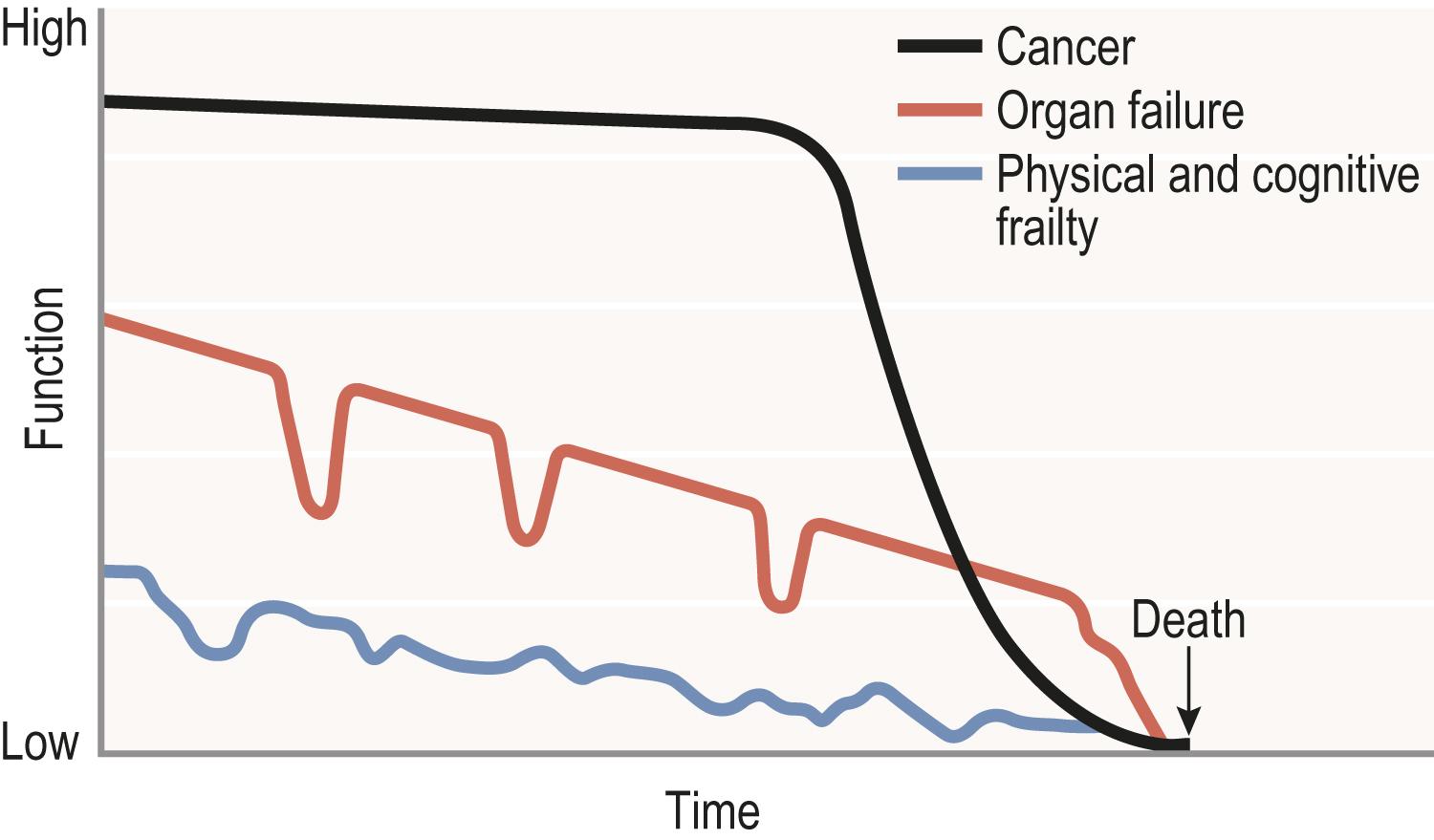Physical Address
304 North Cardinal St.
Dorchester Center, MA 02124
Around 1% of the population in high-income countries die each year. Although some deaths are unexpected, the majority are the result of one or more advanced, progressive conditions and occur in hospital, at the patient’s home or care home, or in a hospice. It is important to identify whether an acute deterioration or a new complication from an underlying health problem is reversible. This change may represent an anticipated decline and indicate that the person is approaching the end of their life. Recognising where a person is on their current illness trajectory and identifying their priorities, goals and preferences allows shared decisions to be made with the patient and their relatives about what further investigations and treatments are appropriate, and about their preferred place of care or death.
There are three broad illness trajectories ( Fig. 19.1 ):
progression of a life-limiting condition with a clear terminal phase: for example, advanced cancer where oncology treatment is no longer of benefit or is given for symptom management.
fluctuating decline with intermittent, potentially life-threatening, acute exacerbations or complications that may result in death: for example, advanced respiratory, heart, kidney or liver disease.
prolonged, gradual decline with acute episodes that may be the final illness such as a chest infection: for example, dementia, general frailty in older age or advanced neurological conditions.

Many physiological and functional changes occur in the final weeks or months of life. General indicators of deteriorating health include:
performance status that is poor or worsening, with the person in bed or in a chair for more than half the day.
increasing number of unplanned hospital attendances or admissions.
persistent symptoms despite optimal treatment of underlying conditions.
progressive weight loss with low muscle mass (cachexia), or difficulty maintaining normal weight.
increasing dependency on others for care and support due to physical and/or mental health problems.
Having considered these clinical indicators of deteriorating health, it can be helpful to ask yourself: ‘Would I be surprised if this person died in the next few months, weeks or days?’ Patients may be close to death when they first present or may fail to improve with treatment, so it becomes clear that they will die soon. It is crucial that we recognise when a person is so unwell that they could die.
In the last days of life, people eat and drink less, sleep more and have physiological changes in breathing patterns, circulation, and in the level of consciousness.
The clinician may already know the patient well, for example, if they are the general practitioner. If not, it is important to gather information about the patient’s underlying conditions, presenting illness, current and previous treatment, family and social/cultural context.
Use all available sources to determine the patient’s previous health status in addition to their presenting problems. Review referral letters, primary care and hospital records, and previous discharge summaries. Check for advance/anticipatory care plans, emergency treatment plans or any advance directive/decision. Find out if the person has a legally appointed, proxy decision-maker or a registered Power of Attorney. Look for any record of previous discussions or decisions about cardiopulmonary resuscitation (CPR). Find out if the person has a pacemaker or any other device that will need to be deactivated now or removed after death; record this clearly.
Build up a picture of the patient’s overall health status and any recent changes, not only the presenting symptoms. A family member or friend can provide valuable additional information and support the patient. If the patient or family cannot provide information, contact someone who knows the person, such as the general practitioner, another member of the primary care team, their hospital specialist or any senior nurse involved in their care.
Become a Clinical Tree membership for Full access and enjoy Unlimited articles
If you are a member. Log in here